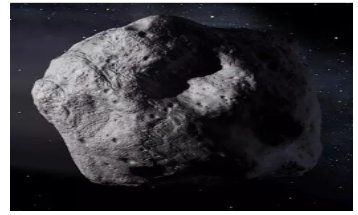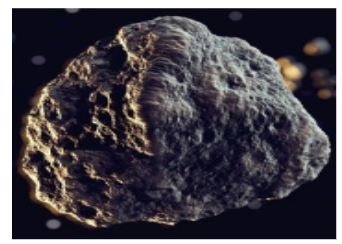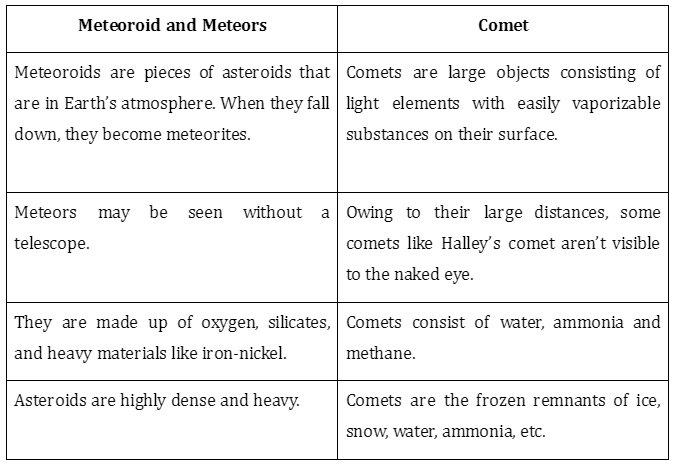Introduction
Astrophysics is a field of study focused on celestial objects such as the sun, comets, stars, asteroids, meteoroids, and galaxies. It aims to understand the birth, life, and death of stars. Asteroids are small objects orbiting the sun and most of them are floating in the portions of our solar system that lie between Mars and Jupiter.
On the other hand, comets are made up of various elements covered with easily vaporizable substances like water, methane, and ammonia. Comets also orbit the sun in elliptical orbits which lie far away from the sun. As they approach closer to the sun, the materials on their surface vaporize and form a “tail” of sorts, which can be as long as 10,000 km. We also have meteoroids, which are partially burnt pieces of asteroids that fall down to Earth.
What is Asteroid?
Asteroids are small celestial bodies that orbit around the Sun and are typically found between Jupiter and Mars in what is known as the asteroid belt. Scientists estimate that this belt contains around 700,000 known asteroids of which only 1,600 orbit the Sun. Note that these are only the known asteroids and there might be several hundred thousand others as well. The asteroid Ceres, with a radius of about 700 km, is the largest asteroid in the belt and takes about four and a half years to orbit the Sun. Although asteroids exert a gravitational pull due to their large size, they lack an atmosphere. Their orbits can be influenced by the gravity of Jupiter or when they get close encounters with Mars. This can sometimes cause them to move out of the asteroid belt and into the orbits of other planets. The International Astronomical Union’s Committee on Small Body Nomenclature assigns names to asteroids.

An asteroid
Classification of Asteroids
Asteroids have been classified into three groups based on their location in our solar system. Further, the composition of the asteroid may also be used as a criteria to classify the asteroids. For instance, C-type asteroids, which are the oldest ones known, are formed of silicate rock and clay and have a very dark appearance. They are also the most common ones. M-type asteroids are metallic and contain combinations of nickel and iron. Finally, S-type asteroids are formed of nickel-iron and silicate materials.
Types of Asteroid
Based on the location of the asteroids, we have:
Main Asteroid Belt: An asteroid belt is a group of asteroids and there is one such belt in our solar system between Mars and Jupiter.
Trojans: Sometimes, asteroids in the main belt can lose their orbit and get into orbit with another planet. They are known as Trojans and their orbits are characterised by two special points known as Lagrangian points.
Near-Earth Asteroids: These are asteroids whose orbits lie close to Earth’s orbit. Some of them can even cross the orbit and are then termed as earth-crossers.
Characteristics of Asteroids
- Asteroids have no specific shape. They may be thought of as randomly shaped bodies with holes on the surface.
- They revolve around the sun in their orbits but their own revolution has no specific direction.
- Some asteroids may have one or even two small companion moons.
What is Meteoroid?
When a comet approaches the sun closely, it disintegrates into smaller fragments. While passing through Earth’s orbit, these fragments can get pulled into our gravitational pull and fall down. Before they enter the atmosphere, they are referred to as meteoroids. However, due to friction with the Earth’s atmosphere, most of these fragments burn up, causing what we know as meteor showers. In this stage, they are known as meteors. Sometimes, though, the fragments are large enough to survive the atmosphere and small pieces that remain after burning up fall down as meteorites.

A meteorite
Composition of Meteoroid
Meteoroids are composed of silicates, oxygen, and a few heavy metals like iron and nickel. Meteoroids can get broken up into smaller fragments due to collision with other objects but generally, the composition remains the same.
Characteristics of Meteoroid
- Meteoroids generally are more dense than Earth’s rocks, owing to the iron and nickel content in them.
- There is a unique thumbprint-like shape of pits on most meteoroids, but they don’t have holes.
- They have random shapes and sizes.
Difference Between meteoroid, meteor, and comet

Summary
Asteroids are celestial objects that orbit the sun in a belt that is located between Mars and Jupiter. This belt consists of millions of asteroids. On the other hand, comets are composed of small, solid particles and covered with substances such as water, methane, and ammonia. When a comet breaks apart and falls on Earth, it’s called a meteoroid. The surfaces of celestial objects like the moon, Mercury, and Mars have craters because of meteoroid impacts. Meteoroids can also be formed by the collision of two asteroids.
Frequently Asked Questions
1. What are the types of Stars?
There are many types of stars, some of which are:
- Double and multiple stars
- Intrinsically variable stars
- Nova and super Nova
2. What is albedo?
The portion of the solar energy that is reflected by a planet is referred to as albedo, and it can help us understand the atmosphere of planets. For instance, Venus has an albedo of 0.85, which means a denser and heavier atmosphere compared to other planets. On the other hand, Mercury has an albedo of 0.06, which corresponds to no atmosphere,
3. Explain Halley’s Comet.
Since comets travel in orbits, some of them are visible from Earth at regular intervals. Halley’s comet has a period of 75-76 years and the last time we saw it was in 1986 and before that, in 1910. This is the only periodic comet that is visible from the Earth with a naked eye.
4. What are the conditions for life on any planet?
- The thermal conditions, i.e., the temperature must be in the survivable range.
- The atmosphere must support life.
- The amount of water on the planet must be considerable.
5. What are White Dwarfs?
White dwarfs are small stars that do not possess the capability for nuclear fusion and consist of elements that are lighter than iron.